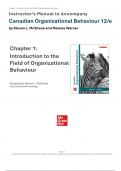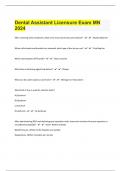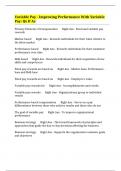Chapter 1: Introduction to the Field of Organizational Behaviour
Instructor’s Manual to Accompany
Canadian Organizational Behaviour 12/e
by Steven L. McShane and Melissa Warner
Chapter 1:
Introduction to the
Field of Organizational
Behaviour
Prepared by Steven L. McShane
Interconnected Knowledge
Page 1-1
Copyright © 2024 McGraw Hill Limited. All rights reserved. No reproduction or distribution without the prior written consent of McGraw Hill.
,Chapter 1: Introduction to the Field of Organizational Behaviour
1 Introduction to the Field
of Organizational Behaviour
LEARNING OBJECTIVES
After reading this chapter, students should be able to:
1-1 Define organizational behaviour and organizations.
1-2 Explain why organizational behaviour knowledge is important for you and for organizations.
1-3 Describe the anchors on which organizational behaviour knowledge is based.
1-4 Summarize the workplace trends of diversity, equity, and inclusion; work-life integration; and remote
work.
1-5 Diagram the MARS model and describe the four factors that directly influence individual behaviour
and performance.
1-6 Summarize the five types of individual behaviour in organizations.
CHAPTER GLOSSARY
ability — the natural aptitudes, learned capabilities, and human capital — the knowledge, skills, abilities,
habits required to successfully complete a task creative thinking, and other valued resources that
employees bring to the organization
adaptive task performance — how well employees
modify their thoughts and behaviour to align with and inclusive workplace — a workplace that values people
support a new or changing work process or work setting of all identities and allows them to be fully themselves
while contributing to the organization
corporate social responsibility (CSR) — organizational
activities intended to benefit society and the MARS model — a model depicting the four variables—
environment beyond the firm’s immediate financial motivation, ability, role perceptions, and situational
interests or legal obligations factors—that directly influence an individual’s
voluntary behaviour and performance
counterproductive work behaviours (CWBs) —
voluntary behaviours that have the potential to directly motivation — the forces within a person that affect the
or indirectly harm the organization direction, intensity, and persistence of effort for
voluntary behaviour
deep-level diversity — differences in the psychological
characteristics of employees, including personalities, open systems — the view that organizations depend on
beliefs, values, and attitudes the external environment for resources, affect that
environment through their output, and consist of
evidence-based management — the practice of making
internal subsystems that transform inputs to outputs
decisions and taking actions based on research evidence
Page 1-2
Copyright © 2024 McGraw Hill. All rights reserved. No reproduction or distribution without the prior written consent of McGraw Hill.
,Chapter 1: Introduction to the Field of Organizational Behaviour
organizational behaviour (OB) — the study of what role perceptions — the degree to which a person
people think, feel, and do in and around organizations understands the job duties assigned to or expected of
them
organizational citizenship behaviours (OCBs) — various
forms of cooperation and helpfulness to others that stakeholders — individuals, groups, or other entities
support the organization’s social and psychological that affect, or are affected by, the organization’s
context. objectives and actions
organizational effectiveness — an ideal state in which an surface-level diversity — the observable demographic or
organization has a good fit with its external physiological differences in people, such as their race,
environment, effectively transforms inputs to outputs ethnicity, gender, age, and physical disabilities
through human capital, and satisfies the needs of key
task performance — the individual’s voluntary goal-
stakeholders
directed behaviours that contribute to organizational
organizations — groups of people who work objectives; includes proficient, adaptive, and proactive
interdependently toward some purpose task performance
proactive task performance — how well employees take work-life integration — the degree that people are
the initiative to anticipate and introduce new work effectively engaged in their various work and nonwork
patterns that benefit the organization roles and have a low degree of role conflict across those
life domains
proficient task performance — how well employees
perform the work efficiently and accurately
remote work — any arrangement whereby an individual
performs organizational tasks while located away from
the employer’s physical premises, usually connected
through various forms of information technology
CHAPTER SUMMARY BY LEARNING OBJECTIVE
1-1 Define organizational behaviour and organizations.
Organizational behaviour is the study of what people think, feel, and do in and around organizations. It examines
how individuals and teams in organizations relate to one another, and how organizations interact with their
external environments. This field of knowledge emerged around the early 1940s, but organizations have been
studied by other disciplines for more than 2,000 years. Organizations are groups of people who work
interdependently toward some purpose. They consist of people who interact with one another in an organized
way and have a collective sense of purpose.
1-2 Explain why organizational behaviour knowledge is important for you and for organizations.
Organizational behaviour is important for you because it offers a core foundation of knowledge and skill
development for your success in organizations. The skills and knowledge that employers look for in new hires,
above anything else, are the topics found in organizational behaviour, including problem solving, working
effectively in teams, communication, and adaptability/initiative. More broadly, OB helps you adopt better
personal theories to understand, predict, and influence organizational events. OB knowledge is for everyone, not
just managers.
OB theories and practices are vital to the organization’s survival and success. In fact, most OB theories implicitly
or explicitly try to improve organizational effectiveness—an ideal state in which an organization has a good fit
with its external environment, effectively transforms inputs to outputs through human capital, and satisfies the
needs of key stakeholders. Organizational behaviour knowledge is highly relevant to the open systems view of
Page 1-3
Copyright © 2024 McGraw Hill. All rights reserved. No reproduction or distribution without the prior written consent of McGraw Hill.
, Chapter 1: Introduction to the Field of Organizational Behaviour
organizations by identifying organizational characteristics that “fit” some external environments better than
others. OB theories offer guidance on how to effectively transform inputs to outputs.
OB is also important for organizations because it identifies ways for organizations to develop and leverage the
potential of human capital—the knowledge, skills, abilities, creativity, and other valued resources that employees
bring to the organization. Several organizational behaviour topics also give us a better understanding of relations
with stakeholders—individuals, groups, and other entities that affect, or are affected by, the organization’s
objectives and actions. This latter focus includes the role of corporate social responsibility—organizational
activities intended to benefit society and the environment beyond the firm’s immediate financial interests or legal
obligations.
1-3 Describe the anchors on which organizational behaviour knowledge is based.
The systematic research anchor states that OB knowledge should be based on systematic research, consistent with
evidence-based management. The practical orientation anchor states that OB theories need to be useful in practice,
such as by helping organizations become more effective. The multidisciplinary anchor states that the field should
develop from knowledge in other disciplines (e.g., psychology, sociology, economics), not just from its own
isolated research base. The contingency anchor states that OB theories generally need to consider that there will be
different consequences in different situations. The multiple levels of analysis anchor states that OB topics may be
viewed from the individual, team, and organization levels of analysis.
1-4 Summarize the workplace trends of diversity, equity, and inclusion; work–life integration; and remote work.
Diversity, equity, and inclusion (DEI) are integrated concepts and practices. Diversity refers to surface-level and
deep-level heterogeneity of the organization’s workforce. Equity is about treating everyone fairly by practising the
various forms of organizational justice. An inclusive workplace refers to how well the organization values
diversity and allows people of all identities to be fully themselves while contributing to the organization. It
enables people of all backgrounds to feel psychologically safe, engaged, valued, authentic, listened to, and
respected. Organizations that support diversity, equity, and inclusion tend to have better decision making,
employee attitudes, team performance, and a host of other favourable outcomes for employees and the
organization. However, diversity also poses challenges, such as dysfunctional conflict and slower team
development.
Work–life integration refers to the degree that people are effectively engaged in their various work and nonwork
roles and have a low degree of role conflict across those life domains. Various work and nonwork roles are
inherently integrated because the physical, cognitive, and emotional resources produced or consumed by one role
potentially enrich or undermine the success and enjoyment of other roles. There are several ways to maximize
work–life integration, such as by doing things that mix two roles, engaging in flexible work scheduling, ensuring
that work and nonwork roles are aligned with your personal characteristics, and engaging in some degree of
“boundary management” across roles.
An increasing percentage of the workforce performs their job remotely some or all of the time rather than at the
organization’s physical work site. Some organizations are completely remote—everyone works at home and cafés
and the company has no physical head office. Working remotely potentially benefits employees and employers,
but there are also disadvantages. The effectiveness of remote work depends on the employee, job, and
organization..
1-5 Diagram the MARS model and describe the four factors that directly influence individual behaviour and
performance.
Four variables—motivation, ability, role perceptions, and situational factors—which are represented by the
acronym MARS, directly influence individual behaviour and performance. Motivation represents the forces within
a person that affect their direction, intensity, and persistence of voluntary behaviour; ability includes both the
natural aptitudes and the learned capabilities required to successfully complete a task; role perceptions are the
Page 1-4
Copyright © 2024 McGraw Hill. All rights reserved. No reproduction or distribution without the prior written consent of McGraw Hill.







